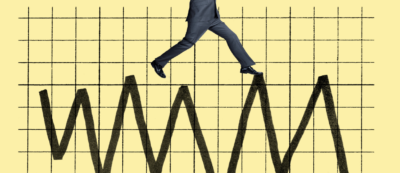Standing in for Peter Warnes this week while he is out on a couple of weeks leave. If memory serves, last time I stood in for Peter with the overview was mid-June 2022. Things were pretty grim. Risk abounded, rates were rising fast, inflation was high and rising quickly, the ASX 200 was down 14% in about two months and bitcoin more than cut in half in a similar period. Bonds were also under the pump. The market was at its steepest discount to our fair value estimate on average in a long time, nearly 15%. Only twice was that discount surpassed in last 15 years. Namely in the depths of the global financial crisis and briefly with the worst of the Covid-19 sell off. The level of concern and the decline in the markets suggested it wasn’t a time to take your money out, but rather to consider adding more.
What now? Timing the market is very difficult, and as Howard Marks of Oaktree points out, probably impossible to do reliably. After all, there is no multi-billion-dollar market timing titan akin to Warren Buffett. Buffett didn’t pick the macro but followed a fundamental company focused investment approach to generate his wealth and stellar returns.
That said, I think our overall price to fair value estimate is worth keeping in mind. It helps to orientate where we think the local market is at and in the past has provided a valuable signal when the median discount or premium strayed materially from our fair value estimates. With the median price to fair value estimate for our ANZ coverage now at just a 4% discount, the measure suggests we’re no longer in the “should I pull all of my money out of the stock market” territory. We touched there in mid-June and late-September 2022. And for investors that means less bargains now compared to then. The big stocks are generally more expensive too with the market cap weighted average at an 8% premium to our fair value estimate.
However, it does not mean don’t invest and it certainly doesn’t mean get out. Remember, it’s time in the market, not timing of the market that matters. And in the long run, being invested in equities, owning quality businesses and participating in the magic of compounding is key. As Buffett says, compounding is the eighth wonder of the world. I’ll concede plenty of risks abound, and in a sense I am surprised the market is not a bit more downbeat given the prevailing conditions, particularly high inflation. However, our median price to fair value estimate suggests we’re in a more normal environment from an overall value point of view.
With inflation looking like it may have peaked in the U.S., and employment still robust, we’re starting to see some green shoots of optimism return, and talk of an impending recession wane. The RBA says inflation has likely peaked here too, as does Woolworths, at least as far as food and supply chains are concerned. We’re seeing headlines from prognosticators such as S&P and the International Monetary Fund that Australia is likely to avoid recession. Peter’s choice of image for his 2022–23 outlook from July last year—a crash landing with no casualties—may prove apt.
But I don’t want to stare deeply into the macroeconomic crystal ball, which is hazy at the best of times. Buffett talks about focusing on what is important and knowable. What we do know is that the market won’t stay in this relatively fairly valued zone forever. And there is a chance it could move meaningfully away from that base in 2023 in either direction. So now is the time to again evaluate portfolios, think “what if” and freshen the game plan for when the market materially moves. Like Eisenhower said, in preparing for battle “plans are useless but planning is indispensable”.
Market recovery brings opportunity to reassess
With the market close to fairly valued, despite still elevated macro risks, it offers a window of opportunity to reassess portfolios. Are there more speculative elements in the portfolio which have recently recovered? Securities perhaps purchased in sunnier times when optimism abounded that you just couldn’t bear to sell in the downturn? Is there now an opportunity to exit some of these where you have serious concerns about their underlying fundamental value or risks? Something like the aforementioned cryptocurrencies could fit into that basket.
Is there anything where the original investment thesis has not played out and is likely broken? Sometimes things don’t play out as we expect, and that’s the nature of investing. Remember Buffett buying airlines a while ago? If there’s something better where you have greater confidence in the value and underlying long-term fundamentals, the original purchase price of a stock that is down should not be a consideration. If option B is materially better than option A and likely to remain so, it doesn’t matter if A is down, making the switch is the right thing to do. Selling is hard, much harder than buying. And as investors we do it far less often. That said, market noise is no reason to sell if the fundamentals are intact and unchanged. As I touched on in my last overview, Mr Market is there to serve you, not instruct you.
Perhaps there are some stocks which have meaningfully benefited from the market’s shift from pessimism to optimism and are now pricing in a “return to normal”. Perhaps some of the China-exposed stocks fit into this basket. Bonds and hybrids are also now realistic investment options. No longer are yields in the low single digits and fixed income can useful in portfolio. If the market continues to rise, the above portfolio considerations would be even more worthy of thought.
However, there is also a risk the market falls materially from here. Former Treasurer Peter Costello, now Chairman of the Future Fund, rightly points out that interest rates are still rising, and the impact of the increases so far are yet to be felt in the real economy. Any tightening of liquidity will impact business activity, sales and earnings, all of which ultimately matter to equity markets. There is also a risk that inflation, though likely peaking, may persist at elevated levels relative to the past couple of decades. That scenario is not really priced into equity markets and it’s conceivable that it could be in 2023.
Fixed income can again have a role here. If markets stay as they are, fixed income can deliver a handy yield. But if equity markets materially fall due to a slowing economy, there is the potential for bonds to appreciate after last year’s horror show, particularly if inflation cyclically falls too. Having some allocation to fixed income now provides an opportunity to switch some of the overall portfolio back into equities should bargains return. That is if the market retests or surpasses the mid-June and late-September
2022 lows.
Now offers a window to plan for future buying opportunities
If a meaningful downturn happens and investors can be both picky on quality and price, now is the time to do the work. The work is a wish list of stocks you’d love to own for the long term.
Assembling the list, understanding the businesses and picking with an eye on growth outlook, resilience, cash flow generation and competitive position. There can also be a trade-off between yield and growth, depending on investor preference. It may also be worth considering what your sources of funds are most likely to be at the time, if the opportunity comes to pass. And perhaps at what price would you like to own said equities, provided there’s a realistic chance of those coming to pass in a downturn. Also important, consider ahead of time what fundamental new information would change your outlook as it can help to counter our instinctive desire to reject that which is contrary.
What would my wish list look like? Well, I’d want businesses with strong competitive positions, pricing power and either robust cash flows and dividends or growth prospects at least in line with nominal GDP growth. Also important is to have diversification. Not just by sector but by investment drivers. It’s a very risky strategy to build a portfolio that superficially looks diversified but if you scratch the surface is dominated by just one theme. In the ANZ market, it’s relatively easy to do. I’d hazard a guess that many portfolios are dominated by either the health of the domestic housing markets, or China’s growth.
This is by no means an exhaustive list of quality businesses to have on your watch list should the market turn down. And I am sure there are many other candidates worthy of consideration. But focusing on the ones that are top of my mind, in basic materials, I’d strongly consider James Hardie or Deterra Royalties. In communications, Telstra, Seek, Carsales and either REA or Domain stand out. There are plenty of worthy candidates in the consumer cyclical sector. InvoCare, Lottery Corp and Domino’s appeal, but the net could be cast wider too. Among the consumer defensives, Endeavour Group dominates its space. Of the financials, the big four banks, Computershare—which benefits from rising interest rates, ASX, the two moaty insurance brokers AUB and Steadfast, and the moat rated health insurers. Healthcare has some particularly strong franchises—Sonic, CSL and Cochlear to name a few. So too industrials with Aurizon, Brambles, Auckland Airport and Transurban. In property, the businesses with high quality properties and an asset management angle such as Goodman and Charter Hall are interesting. In technology, emerging platform businesses Fineos and Wisetech garner my attention. And among utilities, AGL and APA both come to mind. But if markets irrationally sold off, the New Zealand “gentailers” exposed to high quality renewable hydro assets would warrant attention. It’s just often hard to grab them at a decent price though.




